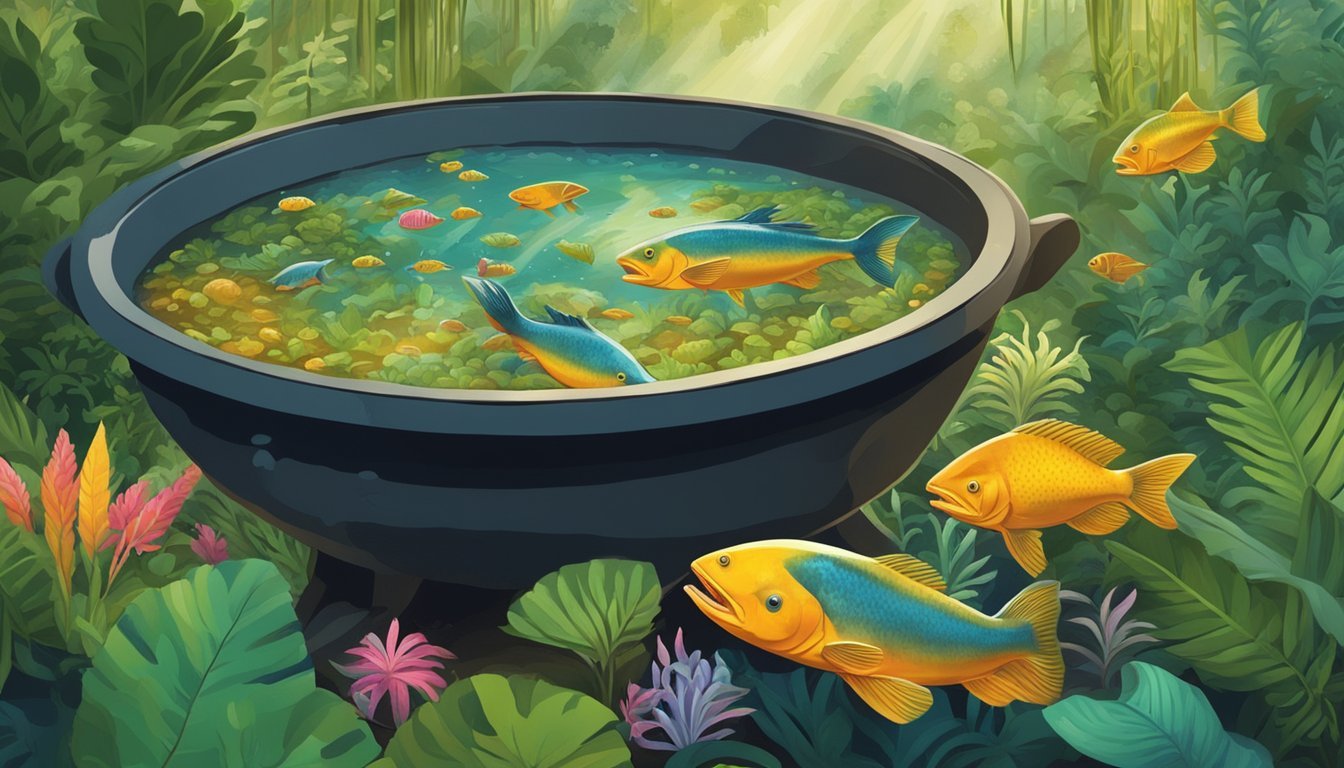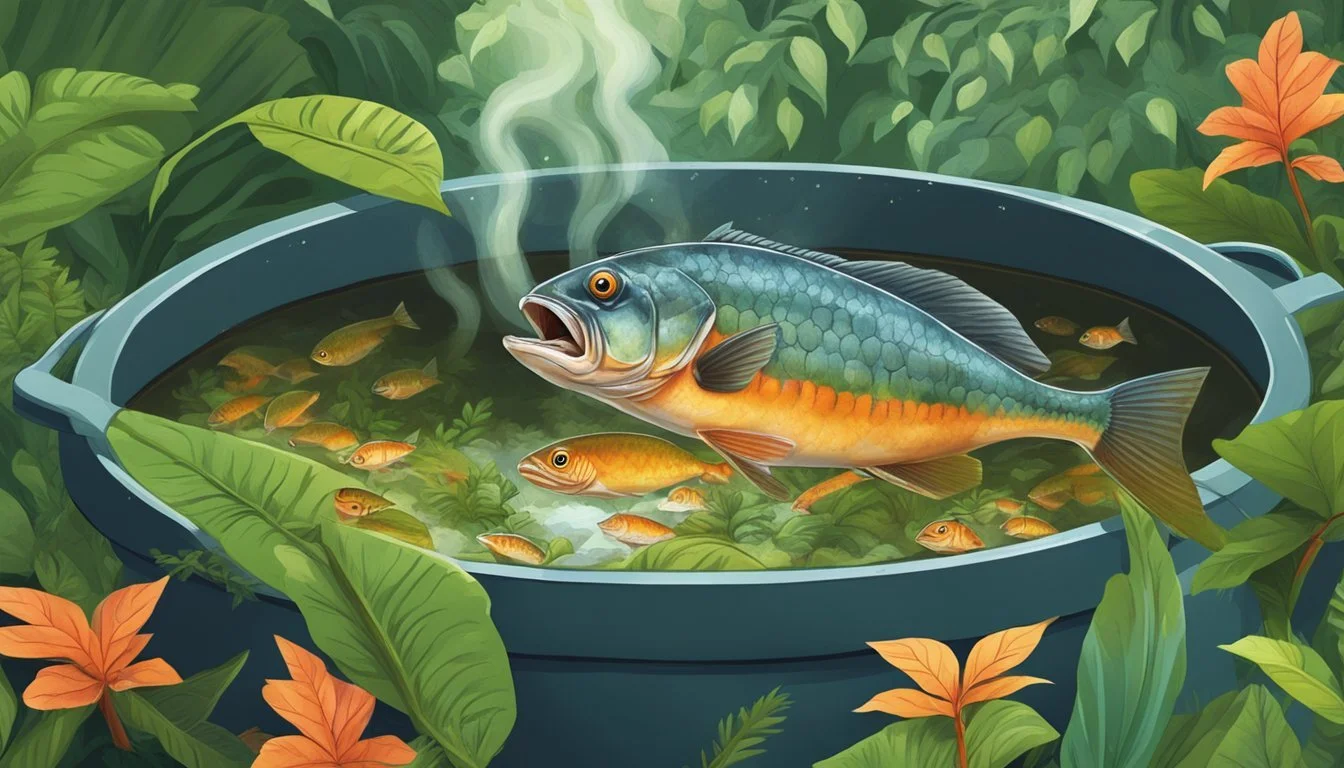Piranha Soup
The Amazonian Dish That Bites Back – A Culinary Adventure
Steeped in the rich culinary traditions of the Amazon, piranha soup emerges as a dish echoing the biodiversity and unique food culture of Brazil. Known locally as 'Caldo de Piranha,' this traditional recipe turns the notorious predatory fish into a flavorful and hearty meal. As piranhas are abundant in the Amazonian waters, this dish reflects the resourcefulness and creativity of local cuisine by transforming a creature that often incites fear into a celebrated and sought-after delicacy.
Creating the soup involves careful preparation, starting with the cleaning and cutting of the fish into manageable pieces—this is a culinary endeavor that requires attention and respect for the ingredients. The recipe activates all senses, from the sizzle of fish lightly browning in a bed of aromatic vegetables to the rich scents wafting from the pot as the dish simmers. The cook is both a craftsman and a storyteller, bringing forth the flavors of the Amazon and drawing diners into an immersive gastronomic experience.
While piranha soup may carry a name that suggests danger, the real bite comes from the zesty blend of ingredients and spices unique to Amazonian cuisine. It’s a taste that transcends the mythos surrounding its main ingredient, allowing both locals and visitors alike to savor the complexity and vibrance encapsulated in this emblematic Brazilian dish.
Understanding Piranhas
Before diving into the flavorful world of Piranha Soup, it's essential to comprehend the fish behind the dish. The piranha is a freshwater fish native to South America's Amazon River basin, known for its biodiversity and as the habitat of numerous piranha species.
Species Overview
The Amazon hosts several species of piranhas, but the most renowned is the red-bellied piranha (Pygocentrus nattereri). Characterized by its strong jaw and sharp, triangular teeth, this species can grow up to 33 cm (13 in) in length and is often highlighted in media as a fearsome predator.
Physical characteristics: Red-bellied piranhas have a robust body, reddish underside, and a reputation for a strong bite.
Diverse species: Piranhas belong to the family Characidae and vary widely in size, behavior, and diet.
Piranhas in the Ecosystem
In their natural Amazonian habitat, piranhas serve as both predators and prey, contributing to the ecosystem's balance. Their role is critical for the health of the aquatic community.
Biodiversity: Piranhas are a part of the Amazon's diverse ecosystem, which includes thousands of freshwater fish species.
Diet: They are omnivores, feeding on insects, fish, crustaceans, and plants.
Ecosystem role: Piranhas help regulate fish populations and serve as food for other predators.
Myths vs. Reality
The portrayal of piranhas as dangerous man-eaters is largely hyperbolic. While they are opportunistic feeders, attacks on humans are rare and usually result in minor injuries.
Attack frequency: Most piranha bites occur when they are threatened or during their breeding season when they are guarding their nests.
Aggression: Red-bellied piranhas can display aggressive behavior, but it is often overstated in tales and movies.
By understanding the true nature of piranhas, their species characteristics, and their role in the Amazon ecosystem, one gains a deeper appreciation for this often-misunderstood fish.
Origins of Piranha Soup
Piranha soup embodies the essence of Amazonian tradition, evolving from a regional delicacy to a dish with cultural and culinary significance that varies subtly by locale.
History in Amazon Cuisine
In the Amazon basin, the humble piranha, a fish often sensationalized for its sharp teeth and aggressive nature, has long been a staple in local diets. Piranha soup, known regionally as caldo de piranha, emerged as a traditional dish within indigenous communities and river-dwelling populations. Initially, it provided a nutritional solution to make use of an abundant resource in the rivers of the Amazon.
Cultural Significance
This dish has transcended its origins as a mere sustenance, gaining a place in Brazilian culture and festivals. In the Colombian Amazon, it is not just food but a symbol of the relationship between the people and the river's bounty. Locals often consider piranha soup to promote strength and are known to attribute medicinal properties to it.
Variations Across Regions
Across the diverse Amazonian landscape, from Brazil to Colombia, the recipe for piranha soup takes on subtle variations. Common ingredients include piranha fish, onions, tomatoes, annatto, chili peppers, and a mix of coriander and parsley, but the spice levels and additional components may vary:
In Brazil's Pantanal region, a robust version of the soup is cherished, often featuring a variety of local spices.
In the Ecuadorian Amazon, more complex preparations are found, sometimes integrating unique Amazonian ingredients such as yucca or plantains.
Preparing the Ingredients
When crafting Piranha Soup, the quality and preparation of the ingredients form the foundation of its bold flavor. It is crucial to select fresh fish and incorporate authentic herbs, spices, and vegetables typical of Brazilian cuisine to ensure an authentic taste experience.
Selecting the Fish
The cornerstone of Piranha Soup is, unsurprisingly, piranhas. One should aim for approximately 4 lbs (2 kg), which is typically about 10 fish. They need to be fresh and thoroughly cleaned. Before cooking, the fish should be cut into large chunks and seasoned with salt and black pepper to enhance their natural flavors.
Herbs and Spices
The distinctive aroma of Piranha Soup is largely attributed to its herbs and spices. Garlic, crushed; and cilantro are essential. Spices like black pepper contribute to the robust profile, while lime juice adds a hint of zest. Tucupi, a regional sauce made from wild manioc, imparts a unique taste but must be used carefully due to its potency.
Vegetables and Additional Ingredients
A variety of vegetables enrich the soup, with onions and tomatoes serving as primary components. They should be diced finely to allow their flavors to meld seamlessly into the broth. In terms of additional ingredients, vegetable oil is used for sautéing, water creates the base of the soup, and hot sauce can be added for an extra kick. These elements should be prepared and measured before combining them with the fish.
The Cooking Process
Crafting a delectable pot of Piranha Soup demands precision and a careful sequence of steps to ensure the robust flavors and unique textures are fully expressed.
Cleaning and Cutting
Prior to cooking, one must diligently clean the piranhas. This involves descaling, gutting, and rinsing the fish thoroughly. One generally cuts the cleaned piranha into large chunks, being mindful to keep the bones intact, as they contribute to both the flavor and body of the soup.
Seasoning and Marinating
The piranha chunks are then seasoned with salt, pepper, and crushed garlic. A blend of fresh-squeezed lime juice and white wine or cider vinegar is used to marinate the fish, which is then left to absorb these flavors for at least an hour.
Simmering the Soup
The marinated piranha is added to a heated pan and cooked until it begins to turn opaque. At this point, other ingredients such as onions, tomatoes, and chili peppers are introduced to the pan. The contents are then covered with water and left to boil, allowing the flavors to meld.
Achieving the Right Texture
Once the fish is tender and the vegetables are well-cooked, the next step is to shred the piranha meat, making sure to remove all bones. Some choose to strain the soup to ensure a smooth texture, while others prefer to puree a portion of the solid ingredients to add creaminess to the soup. A final touch of freshly chopped parsley adds a bright color and a fresh, herbal note to the dish.
Serving and Presentation
The serving and presentation of Caldo de Piranha, a traditional Amazonian fish soup, are rooted in a balance between traditional methods and modern culinary aesthetics. Restaurants may present this signature dish with an emphasis on its hearty nature, while capturing the essence of the Amazon.
Accompaniments
Rice: Often served alongside to complement the soup.
Lime Wedges: For a citrusy accent.
Fresh Herbs: Such as coriander or parsley for garnish.
In its traditional form, Caldo de Piranha might be served in a simple bowl, accompanied by rice to soak up the robust broth. The soup itself often takes center stage, with restaurants typically garnishing with fresh herbs and lime wedges on the side to enhance the flavor.
Traditional vs. Modern Plating
Traditional:
Served in earthenware or simple bowls.
Focus on hearty, generous portions.
Modern:
Artistic plating techniques may be employed for visual appeal.
Olive oil drizzles and herb garnishes for a refined finish.
While traditional presentation prioritizes function and the communal aspect of enjoying a meal together, modern plating in restaurants will often reflect a more elevated approach. Here, the Caldo de Piranha might be drizzled with olive oil to highlight the soup's rich flavor, acknowledging the dish's origins while catering to contemporary tastes.
Health and Nutrition Aspects
Piranha soup is recognized for its robust nutritional profile, particularly due to the piranha fish being a significant source of protein and various minerals. This section covers the aspects of protein and collagen content, mineral benefits, and considerations for allergies associated with this Amazonian dish.
Protein and Collagen Content
Piranha, the main ingredient in the soup, is an excellent source of protein, essential for muscle and tissue repair. It also contains collagen, which supports joint health and can contribute positively to skin elasticity. Piranhas are part of the freshwater fish family, which often includes species like catfish and arapaima, widely regarded for their protein-rich meat.
Mineral Benefits
The consumption of piranha soup offers a range of minerals. These include calcium and phosphorus—important for bone health—and iron, which is crucial for blood production. Fish are naturally rich in minerals, making piranha an excellent choice for those looking to boost their mineral intake. The mineral content varies with the freshness of the fish, and since piranhas are often served fresh, they retain a high mineral density.
Considerations for Allergies
Individuals who are allergic to fish should avoid piranha soup due to the likelihood of allergic reactions. Allergens specific to fish are present in all species, including freshwater varieties like piranhas and catfish. It is essential for consumers with known allergies to consult with a healthcare provider before trying new foods such as piranha soup.
Piranha Soup in Gastronomy
Piranha soup is an intriguing offering in the culinary world, positioned at the intersection of local tradition and adventurous palates. It is not only a food item, but a cultural experience, sought after by travelers to the Amazon region.
Restaurant Experiences
In the heart of the Amazon, restaurants along the Amazon river take pride in serving piranha soup, transforming it into a signature dish that captivates visitors with its exotic appeal. Diners can often enjoy the spectacle of fresh piranhas being prepared by skilled chefs, highlighting the dish's freshness and authenticity.
Local Eateries: They emphasize traditional cooking methods, enhancing the soup's robust flavor with native herbs and spices.
Tourist-centric Restaurants: These establishments may tailor the soup's flavor profile to suit a global palate while still providing an authentic Amazonian dining experience.
The Dish as a Travel Attraction
Travelers come to the Amazon longing for a complete sensory journey, of which piranha soup has become a pivotal element. The allure of dining on a dish made from a fish characterized by sharp teeth and a fierce reputation is compelling for many.
The following points highlight piranha soup's role in the Amazonian travel experience:
Adventure: Sampling piranha soup offers an adventurous culinary experience often sought by those traveling through the Amazon jungle.
Ecotourism: Some travelers may encounter the soup while on eco-friendly tours that offer sightings of pink river dolphins and discussions about local conservation, including responsible fishing practices to avoid depletion of piranha populations.
Health Considerations: Visitors are also informed about precautions against malaria, as reputable local restaurants ensure a safe dining atmosphere.
Conservation and Sustainability
The preparation of Piranha soup, an iconic Amazonian dish, raises important questions regarding the conservation of piranha species and the sustainability of river fish ecosystems.
Impact on Piranha Populations
Piranhas are an integral part of the Amazon ecosystem, playing a critical role in maintaining biodiversity. They are top predators and scavengers that ensure the health of freshwater habitats. However, fishing piranhas for soup and other culinary uses can lead to a decrease in their populations. It's vital to monitor and manage their numbers to avoid upsetting the balance of the ecosystem.
Regulations and Best Practices
The sustainability of piranha fish revolves around the implementation of effective regulations and adherence to best practices for fishing.
Regulatory Measures:
Catch limits: These are established to control overfishing.
Seasonal restrictions: Certain times of the year are off-limits to protect breeding piranhas.
Size restrictions: Ensuring only mature piranhas are caught.
Best Practices:
Selective equipment: Utilization of fishing gear that reduces by-catch.
Community engagement: Involving local communities in sustainable practices.
Supporting protected areas: Encouraging the establishment of conservation zones in the Amazon.
By upholding these measures, the challenge of balancing the demand for this local delicacy with the health of piranha populations and the overall freshwater system they inhabit can be met.
Frequently Asked Questions
What are piranhas, and can they really be eaten?
Piranhas are a type of freshwater fish known for their sharp teeth and a notorious reputation for a ferocious appetite. However, in the Amazonian region, they are also a food source and are indeed edible.
Is Caldo de Piranha a traditional dish, and where is it from?
Yes, Caldo de Piranha is a traditional Brazilian soup heralding from the Pantanal area in Mato Grosso do Sul. It epitomizes the inventive use of local jungle ingredients, showcasing river fish as the main component.
What are the key ingredients in Piranha Soup?
Traditionally, piranha soup incorporates:
Piranha fish, cut into large chunks
Aromatics like onions and garlic
Seasonings including salt, pepper, and regional spices
Vegetables such as tomatoes and bell peppers
Are there any health risks such as malaria associated with this dish?
Eating properly cooked piranha poses no more health risks than consuming other cooked river fish. Malaria is caused by a parasite transmitted by mosquitoes, not by consuming fish.
Can the dish be prepared with young or smaller piranhas?
The soup is commonly made with any available piranha, regardless of size, as long as there is sufficient quantity to flavor the broth.
How does piranha soup fit into the life and culture of local communities?
For local communities, piranha soup is more than sustenance; it's a cultural emblem intertwined with the daily life and survival in the Brazilian jungle, showcasing their harmonious relationship with the river ecosystem.








